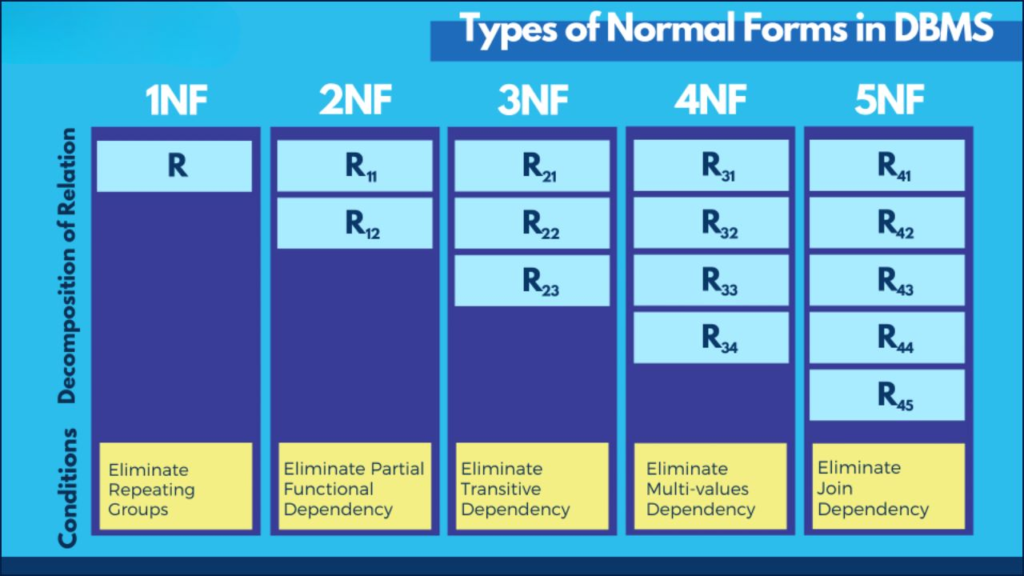
Database normalization is a crucial concept in database management systems (DBMS) that aims to minimize data redundancy and dependency by organizing data efficiently. This process involves transforming data into various normal forms, including First Normal Form (1NF), Second Normal Form (2NF), Third Normal Form (3NF), and Boyce-Codd Normal Form (BCNF). Each of these forms ensures improved data integrity and eliminates unnecessary duplication.
What Is Database Normalization?
Database normalization refers to the process of organizing data within a database to reduce redundancy, improve data integrity, and ensure efficient data storage. The goal is to design a structure where each piece of data resides in the appropriate table, reducing the potential for inconsistencies and anomalies. By adhering to normalization rules, databases become more manageable, scalable, and resilient to errors during data operations.
Key Normal Forms in Database Normalization
First Normal Form (1NF)
Definition:
A table is in 1NF when it meets the following conditions:
- All columns contain atomic values (i.e., no multiple values in a single column).
- Each column contains values of a single type.
- Each row is unique, meaning there are no duplicate rows.
Example:
Consider a table listing student courses:
| StudentID | Name | Courses |
|---|---|---|
| 1 | Alice | Math, English |
| 2 | Bob | Science, History |
The “Courses” column violates 1NF because it holds multiple values. To convert this table into 1NF, we would separate each course into its own row:
| StudentID | Name | Course |
|---|---|---|
| 1 | Alice | Math |
| 1 | Alice | English |
| 2 | Bob | Science |
| 2 | Bob | History |
Now, each cell contains a single value, satisfying the criteria for 1NF.
Second Normal Form (2NF)
Definition:
A table is in 2NF if it is in 1NF and all non-key attributes are fully dependent on the entire primary key, meaning there is no partial dependency (when a non-key attribute depends only on part of a composite primary key).
Example:
Consider a table with the following structure:
| StudentID | CourseID | Instructor | InstructorPhone |
|---|---|---|---|
| 1 | M101 | Dr. Smith | 123-456 |
| 1 | E102 | Dr. Johnson | 789-012 |
| 2 | M101 | Dr. Smith | 123-456 |
Here, “Instructor” and “InstructorPhone” depend only on “CourseID” rather than the whole primary key (“StudentID, CourseID”). To resolve this, we decompose the table into two:
- StudentCourses Table: StudentIDCourseID1M1011E1022M101
- Courses Table: CourseIDInstructorInstructorPhoneM101Dr. Smith123-456E102Dr. Johnson789-012
Now, all non-key attributes depend fully on the primary key, meeting the criteria for 2NF.
Third Normal Form (3NF)
Definition:
A table is in 3NF if it is in 2NF and there is no transitive dependency, meaning non-key attributes should not depend on other non-key attributes.
Example:
| StudentID | CourseID | Instructor | InstructorOffice |
|---|---|---|---|
| 1 | M101 | Dr. Smith | Room 101 |
| 1 | E102 | Dr. Johnson | Room 102 |
| 2 | M101 | Dr. Smith | Room 101 |
In this case, “InstructorOffice” depends on “Instructor” rather than directly on the primary key. To resolve this, we create another table for instructors:
- StudentCourses Table: StudentIDCourseID1M1011E1022M101
- Courses Table: CourseIDInstructorM101Dr. SmithE102Dr. Johnson
- Instructors Table: InstructorInstructorOfficeDr. SmithRoom 101Dr. JohnsonRoom 102
Now, “InstructorOffice” depends only on the “Instructor” and not on any other non-key attribute, satisfying the requirements of 3NF.
Boyce-Codd Normal Form (BCNF)
Definition:
A table is in BCNF if it is in 3NF and every determinant is a superkey. A determinant is an attribute or a set of attributes that uniquely determines another attribute.
Example:
Consider this table:
| StudentID | CourseID | Instructor | InstructorPhone |
|---|---|---|---|
| 1 | M101 | Dr. Smith | 123-456 |
| 1 | E102 | Dr. Johnson | 789-012 |
| 2 | M101 | Dr. Smith | 123-456 |
Here, “Instructor” determines “InstructorPhone,” but “Instructor” is not a superkey. To resolve this, we break the table into two:
- Courses Table: CourseIDInstructorInstructorPhoneM101Dr. Smith123-456E102Dr. Johnson789-012
- StudentCourses Table: StudentIDCourseID1M1011E1022M101
Now, each determinant is a superkey, satisfying BCNF.
Why Is Database Normalization Important?
Database normalization plays a crucial role in ensuring data integrity, preventing anomalies, and optimizing performance in large-scale database systems. By adhering to the normalization process, organizations can:
- Minimize Data Redundancy: Prevent duplicate entries and the associated risk of inconsistencies.
- Improve Query Performance: By organizing data into smaller, well-defined tables, query execution becomes faster and more efficient.
- Maintain Data Integrity: With normalization, relationships between tables become clear, making it easier to maintain and update the database.
Conclusion
Database normalization is an essential practice in the design of relational databases, ensuring that data is stored efficiently and that the risk of anomalies is minimized. The progression from 1NF to BCNF provides a structured approach to organizing data, enabling better data integrity and performance. By understanding these normal forms, database administrators can design systems that are both efficient and scalable, ensuring reliable data management for years to come.

















